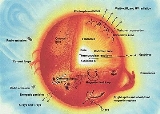
HIP 56948
Encyclopedia
HIP 56948 is a solar twin
star of type G5V
, which as of March 2011, is the most sun-like star yet discovered in terms of size, mass, temperature, chemical makeup and, arguably, age. Our sun is about 4.6 billion years old, and HIP 56948 is believed to be a few million years older—so both stars are between a third and a halfway through their life on the main sequence
.
It is 217 light years
away in the constellation of Draco
, about halfway between Polaris
and Alpha Ursae Majoris. Astronomers have looked for planets in the system, so far without finding any, which implies there are no hot Jupiter
s.
and Iván Ramírez
of the University of Texas analysed the star in 2007 using the 2.7 metre Harlan J. Smith telescope
at McDonald Observatory
.
are unlike the sun in that they have several times the lithium
abundance. HIP 56948 is the best candidate for a solar twin because of the known possible contenders, its lithium abundance most resembles that of our own star. A 2009 high-dispersion spectroscopic study from the Astronomical Society of Japan confirms this.
 In the abstract to their paper, the star's discoverers say:
In the abstract to their paper, the star's discoverers say:
Solar analog
Solar-type, solar analog, and solar twin stars are those stars that are particularly similar to the Sun. The classification is a hierarchy with solar twin being most like the Sun followed by solar analog and then solar-type...
star of type G5V
Stellar classification
In astronomy, stellar classification is a classification of stars based on their spectral characteristics. The spectral class of a star is a designated class of a star describing the ionization of its chromosphere, what atomic excitations are most prominent in the light, giving an objective measure...
, which as of March 2011, is the most sun-like star yet discovered in terms of size, mass, temperature, chemical makeup and, arguably, age. Our sun is about 4.6 billion years old, and HIP 56948 is believed to be a few million years older—so both stars are between a third and a halfway through their life on the main sequence
Main sequence
The main sequence is a continuous and distinctive band of stars that appears on plots of stellar color versus brightness. These color-magnitude plots are known as Hertzsprung–Russell diagrams after their co-developers, Ejnar Hertzsprung and Henry Norris Russell...
.
It is 217 light years
Light Years
Light Years is the seventh studio album by Australian recording artist Kylie Minogue. It was released on 25 September 2000 by Parlophone and Mushroom Records. The album's style was indicative of her return to "mainstream pop dance tunes"....
away in the constellation of Draco
Draco (constellation)
Draco is a constellation in the far northern sky. Its name is Latin for dragon. Draco is circumpolar for many observers in the northern hemisphere...
, about halfway between Polaris
Polaris
Polaris |Alpha]] Ursae Minoris, commonly North Star or Pole Star, also Lodestar) is the brightest star in the constellation Ursa Minor. It is very close to the north celestial pole, making it the current northern pole star....
and Alpha Ursae Majoris. Astronomers have looked for planets in the system, so far without finding any, which implies there are no hot Jupiter
Hot Jupiter
Hot Jupiters are a class of extrasolar planet whose mass is close to or exceeds that of Jupiter...
s.
Discovery
Jorge Meléndez of the Australian National UniversityAustralian National University
The Australian National University is a teaching and research university located in the Australian capital, Canberra.As of 2009, the ANU employs 3,945 administrative staff who teach approximately 10,000 undergraduates, and 7,500 postgraduate students...
and Iván Ramírez
Iván Ramírez
Iván Ramírez is an undefeated Mexican professional boxer in the Middleweight division.-Professional career:...
of the University of Texas analysed the star in 2007 using the 2.7 metre Harlan J. Smith telescope
Harlan J. Smith Telescope
The Harlan J. Smith Telescope is a 2.7m telescope located at the McDonald Observatory, in Texas, in the United States. This telescope is one of several research telescopes that are part of the University of Texas at Austin observatory perched atop Mount Locke in the Davis Mountains of west Texas...
at McDonald Observatory
McDonald Observatory
The McDonald Observatory is an astronomical observatory located near the unincorporated community of Fort Davis in Jeff Davis County, Texas, United States. The facility is located on Mount Fowlkes and Mount Locke in the Davis Mountains of West Texas...
.
Lithium abundance
Other solar analogs such as 18 Scorpii18 Scorpii
18 Scorpii is a star located some 45.3 light years from Earth at the northern edge of the Scorpius constellation.18 Scorpii has many physical properties in common with the Sun. Cayrel de Strobel included it in her review of the stars most similar to the Sun, and Porto de Mello & da Silva ...
are unlike the sun in that they have several times the lithium
Lithium
Lithium is a soft, silver-white metal that belongs to the alkali metal group of chemical elements. It is represented by the symbol Li, and it has the atomic number 3. Under standard conditions it is the lightest metal and the least dense solid element. Like all alkali metals, lithium is highly...
abundance. HIP 56948 is the best candidate for a solar twin because of the known possible contenders, its lithium abundance most resembles that of our own star. A 2009 high-dispersion spectroscopic study from the Astronomical Society of Japan confirms this.
Significance


